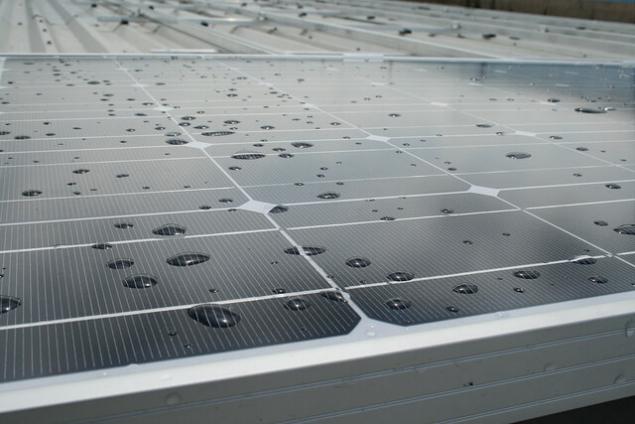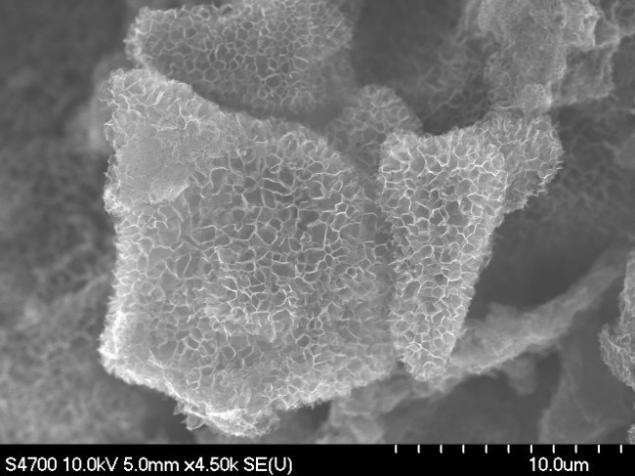Graphene allows solar cells to charge the rain drops
 Bashny.Net
Bashny.Net
Researchers have figured out how to make efficient solar cells to generate electricity even when there is rain.
As is known, in recent years, solar power is gaining popularity. Many technological advances have made fotopaneli very effective and more affordable. However, still a great disadvantage is that solar panels do not produce electricity when there is rain. However, this may change. In the journal Angewandte Chemie, an article appeared on the work of Chinese scientists have developed a new approach to the creation of all-weather solar cells, which can operate from both sunlight and rain drops.

For the conversion of solar energy into electricity team from the Ocean University of China and Yunnan Normal University has developed a highly efficient photochemical dye-sensitized solar cell. In order to enable them to produce energy even from the rain, they covered the dye-sensitized solar panel super-fine film of graphene.

This is a two-dimensional nanocoating form of carbon in which the atoms are linked in the form of honeycombs. It can easily be obtained by oxidation, exfoliation, graphite and subsequent reduction.
Graphene is characterized by its unusual electronic properties: it conducts electricity and is rich in electrons that can move freely throughout the bed (delocalized). In aqueous solution, graphene can bind with positively charged ions by electrons (acid-base interaction between a Lewis). This property is used in graphene-based processes for the removal of lead ions from solutions of organic dyes.

Lewis acid-base interaction is also inspired and Chinese scientists use graphene electrodes to produce energy from the impact of raindrops on the panel. But drops - it is not clean water. The rain contains salts that break down into positive and negative ions.
Positively charged ions including sodium, calcium and ammonium ions, can bind to the surface of the graphene. At the point of contact of a drop of rain, and the water is enriched with graphene and graphene positive ions enriched delocalized electrons. This leads to a double layer of electrons and positively charged ions, a feature known as psevdokondensator.
The resulting potential difference of this phenomenon makes it possible to generate voltage and current.
As is known, in recent years, solar power is gaining popularity. Many technological advances have made fotopaneli very effective and more affordable. However, still a great disadvantage is that solar panels do not produce electricity when there is rain. However, this may change. In the journal Angewandte Chemie, an article appeared on the work of Chinese scientists have developed a new approach to the creation of all-weather solar cells, which can operate from both sunlight and rain drops.

For the conversion of solar energy into electricity team from the Ocean University of China and Yunnan Normal University has developed a highly efficient photochemical dye-sensitized solar cell. In order to enable them to produce energy even from the rain, they covered the dye-sensitized solar panel super-fine film of graphene.

This is a two-dimensional nanocoating form of carbon in which the atoms are linked in the form of honeycombs. It can easily be obtained by oxidation, exfoliation, graphite and subsequent reduction.
Graphene is characterized by its unusual electronic properties: it conducts electricity and is rich in electrons that can move freely throughout the bed (delocalized). In aqueous solution, graphene can bind with positively charged ions by electrons (acid-base interaction between a Lewis). This property is used in graphene-based processes for the removal of lead ions from solutions of organic dyes.

Lewis acid-base interaction is also inspired and Chinese scientists use graphene electrodes to produce energy from the impact of raindrops on the panel. But drops - it is not clean water. The rain contains salts that break down into positive and negative ions.
Positively charged ions including sodium, calcium and ammonium ions, can bind to the surface of the graphene. At the point of contact of a drop of rain, and the water is enriched with graphene and graphene positive ions enriched delocalized electrons. This leads to a double layer of electrons and positively charged ions, a feature known as psevdokondensator.
The resulting potential difference of this phenomenon makes it possible to generate voltage and current.
Tags
Personal development
psychology
women
men
relationships
life
happiness
harmony
love
children
money
wealth
success
See also
Molecular approach to solar energy
Shams 1 - the world's largest solar energy plant
Created the fabric for "smart" clothes that can produce and store solar energy
Farmers from Australia vegetables with solar energy in the desert
MIT breakthrough: thermo-chemical solar power
Paving that collect solar energy
Why will solar energy become cheaper than coal within 10 years
Indian Airport Cochin completely switched to solar energy
New record prices for solar power in Chile
In rural areas of Senegal are set irrigation system on solar energy
















